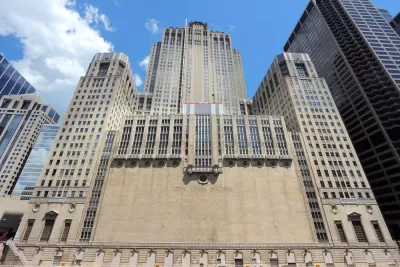The foreclosure risk facing a pair of high-profile office buildings highlight the debt difficulties facing the office sector as it deals with the fallout of the pandemic. The trend could be on the verge of picking up steam.

"Some office properties that've faced sharp occupancy drops since the Covid-19 pandemic are face warnings of possible foreclosure proceedings," reports Ashley Fahey.
Fahey is sharing the results of a Business Journals analysis of bond documents for office properties in the commercial mortgage-backed securities market, finding two high-profile towers (one in Chicago and one in Dallas) "marked as delinquent on debt payments that also are being pushed toward potential foreclosure proceedings by lenders and loan servicers."
The article provides details on the two buildings, the Civic Opera Building in Chicago (a paywalled article published by Crain's Chicago Business reports on a foreclosure lawsuit filed last week for that building) and the Harwood Center in Dallas. The former's occupancy rate fell from 92 percent before the pandemic to 71 percent as of March 2021. The latter's fell from 90 percent to 70 percent.
The aggregate of the data analyzed by the Business Journals finds signs of more general distress:
- "Nationally, 91 office properties or portfolios are in special servicing, with 44% of them marked as delinquent."
- Houston has the most office properties in special services, with seven.
- "Although fewer than 100 office properties or portfolios are in special servicing, there are 782 office properties or portfolios across the U.S. on loan-servicer watchlists, which highlight concerns over a borrowers' abilities to stay current on a existing property debts."
More findings are included in the article below.
FULL STORY: Analysis: High-profile office towers face foreclosure warnings as occupancy slips, debts come due

Trump Administration Could Effectively End Housing Voucher Program
Federal officials are eyeing major cuts to the Section 8 program that helps millions of low-income households pay rent.

Planetizen Federal Action Tracker
A weekly monitor of how Trump’s orders and actions are impacting planners and planning in America.

Ken Jennings Launches Transit Web Series
The Jeopardy champ wants you to ride public transit.

Rebuilding Smarter: How LA County Is Guiding Fire-Ravaged Communities Toward Resilience
Los Angeles County is leading a coordinated effort to help fire-impacted communities rebuild with resilience by providing recovery resources, promoting fire-wise design, and aligning reconstruction with broader sustainability and climate goals.

When Borders Blur: Regional Collaboration in Action
As regional challenges outgrow city boundaries, “When Borders Blur” explores how cross-jurisdictional collaboration can drive smarter, more resilient urban planning, sharing real-world lessons from thriving partnerships across North America.

Philadelphia Is Expanding its Network of Roundabouts
Roundabouts are widely shown to decrease traffic speed, reduce congestion, and improve efficiency.
Urban Design for Planners 1: Software Tools
This six-course series explores essential urban design concepts using open source software and equips planners with the tools they need to participate fully in the urban design process.
Planning for Universal Design
Learn the tools for implementing Universal Design in planning regulations.
Ada County Highway District
Clanton & Associates, Inc.
Jessamine County Fiscal Court
Institute for Housing and Urban Development Studies (IHS)
City of Grandview
Harvard GSD Executive Education
Toledo-Lucas County Plan Commissions
Salt Lake City
NYU Wagner Graduate School of Public Service





























